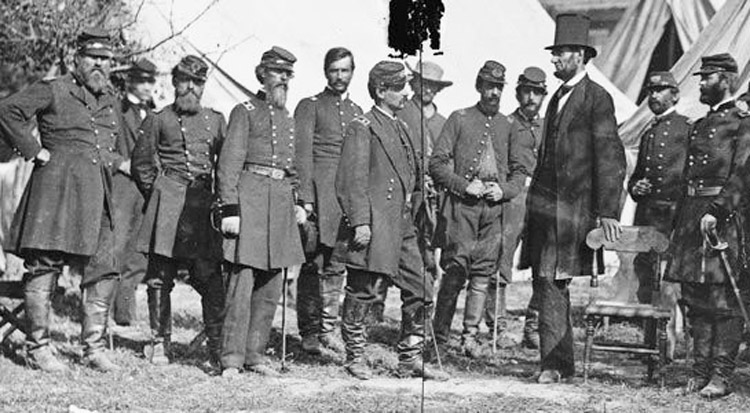America’s Revolutionary Heritage: Marxist Essays by George Novack is one of Pathfinder’s Books of the Month for April. Novack joined the communist movement in the United States in 1933 and remained a member and leader of the Socialist Workers Party until his death in 1992. He wrote a series of valuable books on questions of Marxist politics, history and philosophy available from Pathfinder. This excerpt from the chapter “The Civil War — Its Place in History” is a powerful answer to some liberal or radical political views current today that belittle or deny the revolutionary character of both the 1776 War of Independence and the 1861-65 Civil War. Copyright © 1976 by Pathfinder Press. Reprinted by permission.
BY GEORGE NOVACK
The Civil War had deep historical roots. It was the inevitable product of two interlacing processes. One was the degeneration of the First American Revolution, which unfolded by slow stages until it culminated in open counterrevolution. The other was the rise of capitalist industrialism with its contradictory effects upon American social development. The interaction of these two fundamental factors, the first rooted in national soil and the second stemming from world conditions, constituted the principal driving force in American history between the close of the first revolutionary struggle and the outbreak of the second.
It is impossible to understand the necessity for a Second American Revolution without grasping the dynamics of these two interpenetrating processes out of which it emerged. The First American Revolution took place in the last quarter of the eighteenth century. The second unfolded in the middle of the nineteenth century. Separated by an interval of almost seventy-five years, these two revolutions are customarily regarded as totally different and completely disconnected events. This view is superficial and false. In reality the First American Revolution and the Civil War form two parts of an indivisible whole. They comprised distinct yet interlinked stages in the development of the bourgeois-democratic revolution in the United States.
The bourgeois-national revolutionary movement in North America had five main tasks to fulfill. These were: (1) to free the American people from foreign domination; (2) to consolidate the separate colonies or states into one nation; (3) to set up a democratic republic; (4) to place state power in the hands of the bourgeoisie; and (5) most important of all, to rid American society of its precapitalist encumbrances (Indian tribalism, feudalism, slavery) in order to permit the full and free expansion of capitalist forces of production and exchange. These five tasks were all bound together, the solution of one preparing the conditions for the solution of the rest. …
The social structure of the United States at the end of the eighteenth century was a composite of slave and free labor, of precapitalist and capitalist forms of production. To complete the reconstruction of society along bourgeois lines, it would have been necessary to break up the soil in which slavery was rooted. This proved impossible under the prevailing conditions. The slave interests were sufficiently powerful at the time of the Revolution to prevent any tampering with the institution in its southern strongholds and even to obtain constitutional warrant for its perpetuation. The opponents of slavery could do no more than restrict its scope by providing for the abolition of the foreign slave trade at the end of twenty years, for emancipation in certain northern states where slavery was of slight economic importance, and for its prohibition within the unsettled northwestern territories. …
The victory of the Republican Party in the presidential elections of 1860 and the ensuing departure of the slave states brought to a head the struggle between the southern planters and northern bourgeoisie, the proslavery and antislavery camps, the counterrevolution and the revolution. The secessionist coup d’etat revived all the problems of the bourgeois-democratic revolution, including those which had presumably been forever settled. …
The bourgeois Republicans, who had taken power on a program of restricting the slave power, found that they could hold it against the assaults of the Confederacy only by resorting to increasingly revolutionary measures leading to the overthrow and abolition of the slave power. In order to conserve the conquests of the First American Revolution, it was found necessary to extend them through another. A supplementary upheaval of social-economic relations was required to support the political overturn in 1860.
In the course of this Second Revolution, the most radical representatives of industrial capital and their plebeian allies completed the tasks initiated by their predecessors in the first. Placing themselves at the head of the antislavery forces, the Radicals took complete control of the federal government and concentrated its apparatus in their hands. They defeated the armies of the Confederacy on the battlefields of the Civil War; shattered the political and economic power of the slave oligarchy; consolidated the bourgeois dictatorship set up during the war; and remodeled the Republic into conformity with their own class aims and interests.
This Second American Revolution not only installed a new governing class in office but, by abolishing chattel slavery, scrapped the principal form of property and labor in the South. The great political and social problem which had agitated the United States ever since the birth of the republic — how to dispose of the slave power and its “peculiar institution” — was definitively settled.
The Second Revolution also concluded the progressive political role of the American bourgeoisie. After it helped annihilate the slave power and slavery, its political usefulness was utterly exhausted. Like the plantation aristocracy before it, the new ruling capitalist oligarchy rapidly transformed itself into a thoroughly reactionary force, until it came to constitute the main obstacle to social progress not only within the United States but throughout the world.


